Investing
US Regulators Take Emergency Measures as 3 Banks Fail in a Week

Published:
Last Updated:

Over the weekend, regulators in the US approved plans to backstop depositors and financial institutions linked with now-collapsed Silicon Valley Bank and Signature Bank, a crypto-friendly bank shut down on Sunday over systemic contagion fears. In a joint statement, the Federal Reserve and the US Treasury said depositors in both banks would be made whole.
It has been a hectic week for the American banking system. Signature Bank, one of the most popular destinations for crypto companies, was shut down by the New York regulators on Sunday to mark the third US bank failure within a week. Silicon Valley Bank and Silvergate Bank were the two other banks that collapsed earlier in the week.
As reported, Silvergate Bank’s parent company, Silvergate Capital Corporation, announced Wednesday that it has decided to wind down its operations and liquidate its subsidiary. The move came as the bank has been under significant pressure since FTX went bankrupt in November, even suffering a run.
Just two days after the collapse of Silvergate, SVB Financial Group, one of the most popular lenders to Silicon Valley tech and growth startups, failed after a run on the bank. On Friday, the Federal Deposit Insurance Corporation (FDIC) took control of the bank and created the Deposit Insurance National Bank of Santa Clara, which now holds the insured deposits from SVB.
“Silicon Valley Bank, Santa Clara, California, was closed today by the California Department of Financial Protection and Innovation, which appointed the Federal Deposit Insurance Corporation as receiver,” the federal agency said in a press release Friday.
On Sunday, US regulators announced emergency measures to avert a banking crisis and restore confidence in the banking system. The US Federal Reserve, Treasury Department, and the FDIC announced they would use the FDIC’s insurance funds to prevent depositors from losing money.
“Depositors will have access to all of their money starting Monday, March 13. No losses associated with the resolution of Silicon Valley Bank will be borne by the taxpayer,” the regulators said in a joint statement, noting that it will backstop both firms’ uninsured depositors and make more funding available to the banking system.
However, the regulators said that shareholders and certain unsecured debt holders would not be protected, adding that they have also exempted senior management. “Any losses to the Deposit Insurance Fund to support uninsured depositors will be recovered by a special assessment on banks, as required by law.”
The Fed’s facility is implemented using section 13(3) of the Federal Reserve Act, which has permitted emergency lending to banks if they face a surge of withdrawals. This section was added at the height of the Great Depression in 1932 to expand the Fed’s emergency-lending authority.
Notably, section 13(3) was primarily deserted from its introduction until the financial crisis of 2008, when the Fed used it to provide liquidity support to multiple financial institutions and markets affected by the crisis. The Fed used section 13(3) again in 2020 when financial markets were disrupted after the COVID-19 pandemic.
The Fed introduced a new Bank Term Funding Program (BTFP), offering additional funding to eligible depository institutions. “This action will bolster the capacity of the banking system to safeguard deposits and ensure the ongoing provision of money and credit to the economy,” the central bank said in a statement.
The next FOMC meeting, where the Fed will review economic and financial conditions to set benchmark interest rates, is on March 21 and 22. Federal Reserve Chair Jerome Powell suggested last week that another 50 basis point rate hike is likely coming in the next meeting.
However, recent events, including the collapse of three US banks, have given the financial markets a new direction. Still, the CME Group’s Fed Watch Tracker expects a 50 basis points rate hike as the Fed remains determined to tame soaring inflation.
It is worth noting that the Fed will also consider the jobs and inflation data for February in setting the benchmark interest rate. As reported, the latest jobs data showed the US economy added 311,000 jobs in February, smashing the economists’ expectations of 205,000 jobs. The following CPI report is scheduled for Tuesday.
Meanwhile, Friday was mostly downhill for the Nasdaq Composite, the S&P 500, and the Dow Jones. The tech-heavy Nasdaq Composite plunged by around 1.76% to finish at 11,138. The Dow dropped 345 points (1.07%) to close at 31,909, while the S&P 500 lost 1.45% to close at 3,861.
This article originally appeared on The Tokenist
Credit card companies are at war. The biggest issuers are handing out free rewards and benefits to win the best customers.
It’s possible to find cards paying unlimited 1.5%, 2%, and even more today. That’s free money for qualified borrowers, and the type of thing that would be crazy to pass up. Those rewards can add up to thousands of dollars every year in free money, and include other benefits as well.
We’ve assembled some of the best credit cards for users today. Don’t miss these offers because they won’t be this good forever.
Flywheel Publishing has partnered with CardRatings for our coverage of credit card products. Flywheel Publishing and CardRatings may receive a commission from card issuers.
Thank you for reading! Have some feedback for us?
Contact the 24/7 Wall St. editorial team.